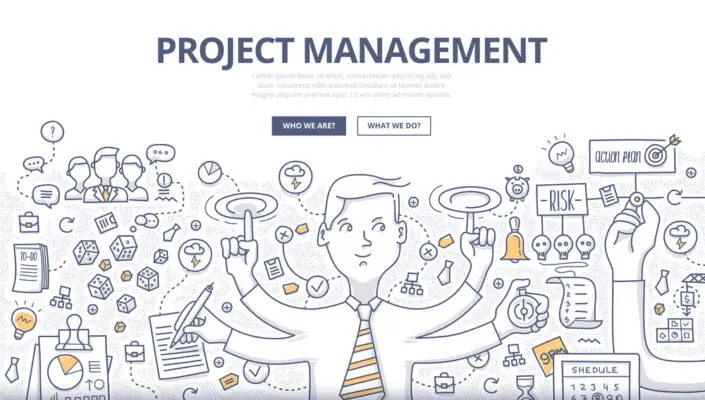A project cutover is when a system, application, or process switches from a legacy environment to a new one. This is often the final stage of a project, where all components are moved from a testing or staging environment into a live or production environment.
This transition is typically done during off-peak hours to minimize the impact on users and operations, often over a weekend or during planned downtime. It involves a carefully coordinated sequence of events and often includes:
Data Migration: Data from the old system is transferred to the new one. This can be a complex task, especially if there is a lot of data or the data structures in the new system differ from the old one.
System Setup: The new system is configured and prepared for use. This can include setting up servers, configuring software settings, and integrating with other systems.
User Training: Users are trained on how to use the new system. This can be done before the cutover, but additional training or support might be needed during the cutover period to deal with any unexpected issues or questions.
Testing and Validation: The new system is tested to ensure it works as expected. This includes checking that all data was transferred correctly, that all features work properly, and that performance is acceptable.
Switching Over: The old system is shut down and the new system is brought online. Users start using the new system and stop using the old one.
Support: There is usually increased support after the cutover to address any issues or questions.
The project cutover is a critical time in a project, as it’s when the new system is put to the test. Thorough planning, testing, and clear communication are key to a successful cutover.
In project management, a cutover plan is a critical document that outlines the steps required to transition from an old system or process to a new one.
It typically includes details on timelines, responsibilities, risk mitigation strategies, and communication plans. A cutover plan is essential for minimizing disruptions and ensuring the smooth implementation of changes.
The success of any project often depends on effective planning and execution of the cutover phase. This can be particularly challenging when dealing with complex systems or processes that involve multiple stakeholders across different departments or locations.
As such, it’s crucial for project managers to have a thorough understanding of what a cutover plan entails and how to create one that meets the unique needs of their specific project.
In this article, we’ll explore in depth what a cutover plan is, why it’s important, the key components involved in creating one successfully, and examples of successful cutover plans in practice.

Definition of a Cutover Plan in Project Management
The definition of a cutover plan in project management refers to a comprehensive strategy that outlines the sequence of activities required to transition from an old system or process to a new one with minimal disruption to business operations.
It involves thorough planning and coordination among stakeholders, such as project managers, IT specialists, end-users, and vendors.
The cutover plan typically includes specific timelines, tasks, responsibilities, and contingency measures to ensure a smooth migration. One of the benefits of having a cutover plan is that it helps minimize risks associated with the transition process.
Organizations can avoid downtime or data loss that could negatively impact their bottom line by identifying potential issues and developing mitigation strategies accordingly.
Moreover, effective communication and collaboration among team members are critical elements of successful cutover plan implementation. When everyone involved understands their roles and responsibilities in executing the plan, they can work together seamlessly to achieve the desired outcomes.
Implementing a cutover plan requires careful consideration of several factors, such as resource availability (e.g., staff skills), technical feasibility (e.g., compatibility between systems), and financial constraints (e.g., budget limitations).
Therefore, project managers must conduct rigorous planning before embarking on this process. They should also monitor progress continuously during execution while making necessary adjustments.
Importance of a Cutover Plan
Significant preparation is necessary to ensure a seamless transition from the current system to the new one, minimizing disruptions and avoiding any negative impact on business operations. This is where a cutover plan comes in handy.
A cutover plan is an essential project management document that outlines procedures for transitioning from an old system to a new one. It details all tasks, responsibilities, timelines, and resources required to implement the new system successfully.
One major reason why a cutover plan is crucial in project management is that it helps mitigate common challenges that often arise during system transitions. These may include data loss or corruption, system downtime or unavailability, software compatibility issues, and user resistance to change.
The cutover plan provides guidelines on addressing these challenges by identifying potential risks and developing strategies for mitigating them before they occur.
In conclusion, having a well-defined cutover plan can significantly reduce the risk of failure during system implementation projects. It ensures that everyone involved in the process understands their roles and responsibilities and has access to resources needed for success.
By anticipating potential problems through detailed planning and mitigation strategies, businesses can minimize disruptions while maximizing benefits when transitioning from an old system to a new one.
Components of a Cutover Plan
A comprehensive set of procedures and guidelines is necessary to ensure a smooth transition from the old system to the new one. This is where the cutover plan comes in, providing a roadmap for executing the switch from old to new systems.
A crucial component of any cutover plan is its timeline, which should be well-defined and include all critical milestones such as testing, data migration, training, and go-live.
Effective communication is also an essential component of a successful cutover plan. Communication must happen at every stage of the process, both internally within the project team and externally with stakeholders such as users impacted by changes.
Stakeholders need to know what’s happening at each implementation stage to prepare accordingly and make any necessary adjustments.
The cutover plan should include contingency plans if unexpected challenges arise during execution. For example, if a particular application or service fails during the migration process, there should be an established backup plan that allows for quick resolution without compromising other aspects of the transition.
A well-prepared cutover plan ensures that implementation runs smoothly and efficiently while minimizing disruption to business operations or user experience.
Creating a Successful Cutover Plan
Developing a detailed timeline with critical milestones and establishing effective communication channels are key factors in creating a successful cutover plan. A detailed timeline should include all necessary tasks, their dependencies, and deadlines to ensure the project stays on track.
Critical milestones should be established to track progress and identify any potential issues that may arise during the transition.
Effective communication channels are also essential for a seamless transition from an old system to a new one. Communication among stakeholders should be clear, concise, and timely.
Regular status updates should be provided to inform everyone of progress and any changes in the project’s scope or timeline. Additionally, it is important to establish escalation procedures for addressing any issues that may arise during the cutover process.
When developing a cutover plan, key considerations include identifying risks and implementing contingency plans to mitigate those risks. Common challenges associated with executing a cutover plan include data migration errors, unexpected downtime, lack of resources or expertise, and resistance from end users.
These challenges can be addressed by conducting thorough testing before the cutover date, ensuring adequate resources are allocated for each task, training end-users on the new system well before the go-live date, and having backup plans in place for any unforeseen issues.
Creating a successful cutover plan requires careful planning, attention to detail, effective communication channels among stakeholders involved in the project execution phase, and contingency planning for identified risks.
Examples of Successful Cutover Plans
Providing specific company examples with their detailed cutover plans might not be possible due to confidentiality issues. Still, we can discuss general best practices that have led to successful cutover plans. Here are some elements seen in successful cutover plans:
1. Comprehensive Planning:
A well-known global manufacturing company was transitioning from its legacy ERP system to a new one. The cutover plan encompassed detailed timelines, step-by-step procedures, and backup plans to ensure minimum disruption to their operations.
A full year was devoted to planning and testing the cutover plan, which ensured a smooth transition with minimal unexpected disruptions.
2. Detailed Testing and Dry Runs:
In another example, an international bank was implementing a new banking software. Before the cutover, the project team performed multiple dry runs in the test environment that replicated the production environment.
This thorough testing identified potential issues that could be fixed before the cutover, leading to a successful transition.
3. Clear Communication and Training:
A large hospital system in the U.S. switched to a new Electronic Health Records system. The cutover plan included extensive training sessions for all users before the transition.
The hospital’s communications team was critical in informing everyone about the upcoming changes, training schedules, and support available during the transition, contributing to the successful cutover.
4. Round-The-Clock Support:
An e-commerce company migrating to a new platform scheduled its cutover during low traffic to minimize customer impact. They also arranged for 24/7 technical support during and after the cutover to resolve any issues that arose promptly. This ensured that their operations were back to normal shortly after the cutover.
5. Risk and Contingency Planning:
When a telecom giant upgraded its customer management system, the project team created a detailed risk assessment as part of the cutover plan. The team also devised contingency plans for all identified risks. As a result, when a major issue was encountered during the transition, the team could implement the contingency plan and avoid significant disruption quickly.
These examples show that a well-thought-out and executed cutover plan, with thorough testing, clear communication, support, and contingency measures, significantly contributes to successful system transitions.
Case Studies
Case studies provide real-world examples of successful cutover plans in project management. These case studies help project managers understand the real-world challenges they may face during cutover and how to overcome them.
One such example is the case study of a financial institution that was launching a new core banking system.
The implementation team developed a detailed plan, including thorough testing, training, and contingency measures. They also communicated regularly with stakeholders to ensure everyone knew about the upcoming changes.
Another case study involves an IT company that needed to migrate its data center to a new location while ensuring business continuity. The implementation strategy involved conducting several dry runs to identify and address potential issues before the cutover date.
They also engaged key stakeholders early in the planning process and provided regular updates throughout the migration. As a result, the company experienced minimal downtime and disruption during the cutover process.
These case studies demonstrate that effective planning, communication, testing, and stakeholder engagement are crucial elements for successful cutover plans in project management.
Lessons Learned and Best Practices
Reflecting on past experiences of cutover plans in project management can provide valuable lessons learned and best practices for future implementation efforts. One of the most common challenges during cutover is ensuring the plan is comprehensive and covers all aspects of the transition process.
This requires a detailed analysis of potential risks, dependencies, and critical paths that could affect the success of the cutover.
Additionally, it is essential to establish clear communication channels among all stakeholders involved to ensure everyone understands their roles and responsibilities.
Another crucial aspect of successful cutover planning is having effective implementation strategies in place. This involves identifying key milestones, establishing timelines for each activity, and assigning resources accordingly. It also includes testing procedures to ensure no issues or errors during the transition phase.
Project managers can proactively mitigate risks by implementing these strategies while ensuring all activities are completed on time and within budget constraints.
Reflecting on past experiences and applying best practices can enhance future cutover planning efforts by improving efficiency, reducing risks, and increasing project success rates.

Frequently Asked Questions
How does a cutover plan differ from a project plan?
The main differences between cutover and project plans lie in the focus of each plan. While a project plan outlines the overall objectives and tasks, a cutover plan details the steps required to transition from old to new systems. Creating a cutover plan ensures minimal disruption during this critical implementation phase.
Who is responsible for creating and implementing a cutover plan?
Responsibility allocation for creating and implementing a cutover plan lies with the project manager, who should involve relevant stakeholders. This ensures all parties understand their roles and responsibilities in transitioning from old to new systems or processes.
What common challenges are faced during a cutover process, and how can they be addressed?
During a cutover process, everyday challenges such as system downtime and data loss can arise. To mitigate risks, thorough testing and contingency planning should be implemented. Effective communication and collaboration among stakeholders can also prevent issues from escalating.
Can a cutover plan be modified during the implementation phase of a project?
During the implementation phase of a project, adjustments to the cutover plan may be necessary, including adjusting the timeline and communication strategy. Proactive planning and clear communication among team members can help ensure successful modifications.
How can the success of a cutover plan be measured and evaluated?
Metrics tracking and post-implementation review are essential for evaluating the success of a cutover plan. Detailed analysis of key performance indicators, such as downtime and user feedback, can help identify areas for improvement and inform future planning efforts.

Conclusion
A cutover plan is an essential component of project management that ensures a smooth transition from the old system to the new one. It involves identifying potential risks, developing mitigation strategies, and detailing specific steps for implementing the new system.
A successful cutover plan must be meticulously planned and executed precisely to minimize disruptions and downtime. A comprehensive cutover plan includes data migration, testing, training, communication, and contingency planning.
Successful examples of cutover plans can be found in various industries, such as healthcare, finance, and technology.

Chris Ekai is a Risk Management expert with over 10 years of experience in the field. He has a Master’s(MSc) degree in Risk Management from University of Portsmouth and is a CPA and Finance professional. He currently works as a Content Manager at Risk Publishing, writing about Enterprise Risk Management, Business Continuity Management and Project Management.

